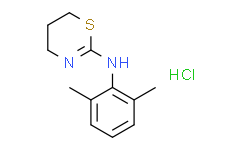| 中文名称: | 甲苯噻嗪 盐酸盐 促销 | ||||
|---|---|---|---|---|---|
| 英文名称: | Xylazine hydrochloride | ||||
| 别名: | 2-(2,6-二甲基苯基)-5,6-二氢-4H-噻嗪-胺 盐酸盐 Xylazine hydrochloride | ||||
| CAS No: | 23076-35-9 | 分子式: | C12H16N2S.HCl | 分子量: | 256.79 |
| CAS No: | 23076-35-9 | ||||
| 分子式: | C12H16N2S.HCl | ||||
| 分子量: | 256.79 | ||||
| MDL: | MFCD00058196 | EINEC: | 8685 | ||
| EINEC: | 8685 | ||||
基本信息
|
产品编号:X10007 |
|||||
|
产品名称:Xylazine hydrochloride |
|||||
|
CAS: |
23076-35-9 |
储存条件 |
粉末 |
-20℃ |
四年 |
|
|
|
||||
|
分子式: |
溶于液体 |
-80℃ |
六个月 |
||
|
分子量: |
256.79 |
-20℃ |
一个月 |
||
|
化学名: |
|
||||
|
Solubility (25°C) |
体外 |
DMSO |
51mg/mL (198.6mM) |
||
|
Ethanol |
51mg/mL (198.6mM) |
||||
|
Water |
51mg/mL (198.6mM) |
||||
|
体内(现配现用) |
|
|
|||
|
<1mg/ml表示微溶或不溶。 |
|||||
|
普西唐提供的所有化合物浓度为内部测试所得,实际溶液度可能与公布值有所偏差,属于正常的批间细微差异现象。 |
|||||
|
请根据产品在不同溶剂中的溶解度选择合适的溶剂配制储备液;⼀旦配成溶液,请分装保存,避免反复冻融造成的产品失效。 |
|||||
制备储备液
|
浓度
溶液体积 质量 |
1mg |
5mg |
10mg |
|
1mM |
3.8942mL |
19.4712mL |
38.9423mL |
|
5mM |
0.7788mL |
3.8942mL |
7.7885mL |
|
10mM |
0.3894mL |
1.9471mL |
3.8942mL |
|
50mM |
0.0779mL |
0.3894mL |
0.7788mL |
生物活性
|
产品描述 |
一种肾上腺素α-2激动剂,lasmodium falciparum:IC50:5.01μM。 |
|
|
靶点/IC50 |
α2-adrenergic |
|
|
体内研究 |
Xylazine (5.2mg/kg;intraperitoneal injection;for 10-60 minutes;male Sprague-Dawley rats) administration alters mRNA expression and protein phosphorylation levels of AMPK signaling molecules,suggesting that the LKB1-AMPK pathway plays a role in the sedative and tranquilizing effects in the CNS caused by Xylazine treatment. |
|
|
Animal Model: |
Male Sprague-Dawley rats (160-180g) |
|
|
Dosage: |
5.2mg/kg |
|
|
Administration: |
Intraperitoneal injection;for 10 minutes,20 minutes,40 minutes or 60 minutes |
|
|
Result: |
Increased in AMPK activity in the cerebral cortex,hippocampus,thalamus and cerebellum.Phosphorylated LKB1 and AMPKα protein levels were decreased. |
|
本计算器可帮助您计算出特定溶液中溶质的质量、溶液浓度和体积之间的关系,公式为:
质量 (g) = 浓度 (mol/L) x 体积 (L) x 分子量 (g/mol)
摩尔浓度计算公式
用本工具协助配置特定浓度的溶液,使用的计算公式为:
开始浓度 x 开始体积 = 最终浓度 x 最终体积
稀释公式
稀释公式一般简略地表示为:C1V1 = C2V2 ( 输入 输出 )









